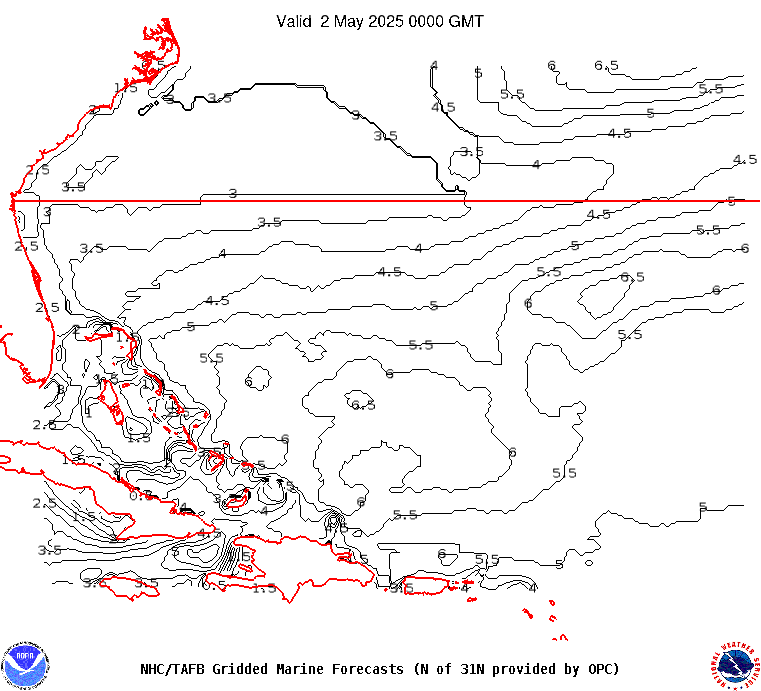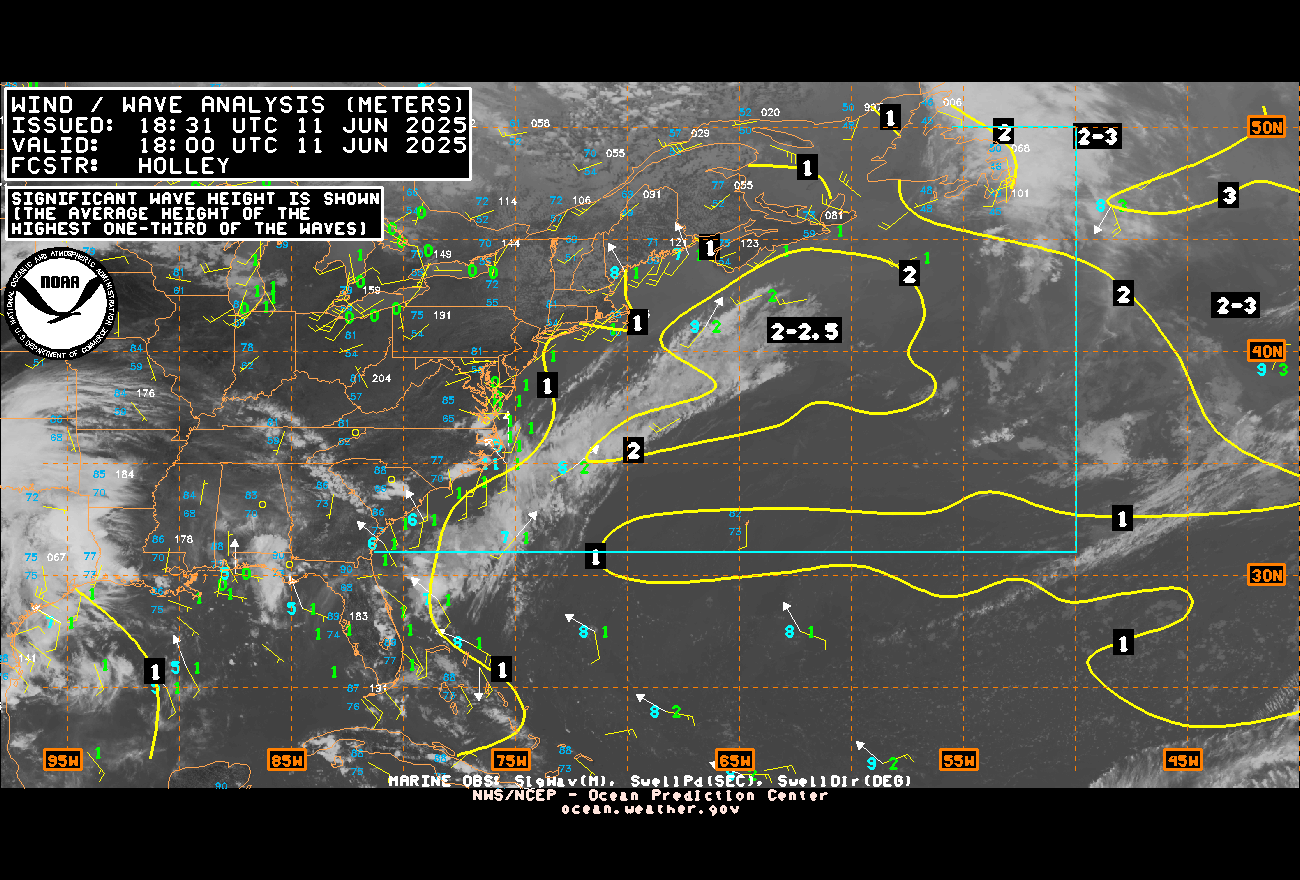FLORIDA EAST COAST MARINE WEATHER (edited by Dean)
A series of cold fronts will sweep through Florida through mid-January, pushed by cold Canadian and Arctic fronts ushering in on moderate to strong NW/N winds, and the cold will only briefly moderate with barely a day of milder (near normal) temperatures ahead of each blast. Waves will be relatively small ahead of and immediately behind the fronts, though several moderate upticks in angled north swell (more size south) will be noted behind the progressively colder fronts that push through Florida every 3 days or so. The main hope for significant improvement in size next week in the wake of a departing low pressure area as strong Arctic high pressure builds down the Atlantic coast into Florida, creating a strong N/NE fetch. Latest model run indicate this scenario will lead to a multiple-day, sizeable moderate to longer period swell. Bottom line, it’s going be getting dang cold, and generally mediocre size/quality along with surf temps hammered down in the 50’s north of the Cape make points south very attractive- stay tuned…
DEAN’S 7-DAY SURF FORECAST
TUESDAY: Cold wind continuing from the north 13-20 mph with waves starting out early at 1-2′ (+south) in close to moderate period (6 sec) drifty NNE/NE swell, adding more size during the day. Increasing clouds will give way to a cold rain as the day progresses, and the steady northerly wind will make it feel like the 40’sF north of the Cape. Surf temperatures will drop a degree or so into the mid-50’sF in the St. Augustine area.
WEDNESDAY(22Jan): Cold/raw wind N/NNE 17-25 mph in the morning along with coastal rain showers likely (ice possible Jax north into coastal GA) and waves building to 2.5-3′ (++south) in moderate period (7-8 sec) NE swell. Wind should gradually ease a bit later in the afternoon.
THURSDAY: Wind N/NNW 12-17 mph with waves starting out at 2-3′ (occ+) in moderate to longer period (8-9 sec) NE/ENE swell, shedding some size as the day progresses as the wind backs more side-offshore and eases some in the afternoon.
FRIDAY: Wind backing NW 8-15 mph with waves starting out at 1.5-2.5′ (+/-0.5′) in moderate to long period (8-10 sec) ENE/E swell, shedding more size in the afternoon. It would not be a surprise if the surf temps St.Augustine north to Jacksonville Beach bottom out in the low 50’sF… arguably the lowest in over a decade and a half (since January 2010).
SATURDAY(25Jan): Wind light NW in the morning, becoming variable to onshore 5-10 mph in the afternoon with waves 1-occ 2′ (+/-0.5′) in moderate to long period (9-occ 11 sec) east mix swell.
SUNDAY: Wind calm to light/variable in the morning, becoming east 5-13 mph in the afternoon with waves 1-1.5′ (+/-0.5′) in moderate to long period (8-occ/inc 10 sec) easterly swell.
Ocean conditions monitoring notes/links: With the outbreaks of marginally moderated polar air ushered in by brisk NW/N winds behind a rapid-fire progression of January cold fronts, a good winter-time gauge of fluctuating surf temperatures along the NE Florida coast may be found from upstream readings at the closer to the shore Fernandina Beach buoy. This buoy dropped below 60F around Christmas and will drop down to the mid-50’sF (possibly lower) the 3rd week in January given multiple outbreaks of Arctic air. It would not be suprising to see surf temps north of the Cape bottom out in the low 50’sF, then stay below 60F well into February. The temperature reported by the buoy a few miles east of Fort Pierce reported as 64F on 1/16/25, and the Lake Worth pier surf temperature was 73F.
Use the local buoy 40 miles offshore from St. Augustine to determine swell arrival in a matter of several hours. Further ESE out in the Atlantic, the NE Bahamas buoy #41047 and buoy #41046 east of the central Bahamas broke free of their moorings during the flurry of tropical activity this hurricane season and are currently adrift in the Atlantic. Until these buoys are restored, buoy # 41049 300 nautical miles SSE of Bermuda may be monitored for fetch/duration of easterly swell to estimate the wave potential a day or two ahead.
Unfortunately, buoy #41002 225 nautical miles south of Hatteras went adrift on December 30th after remaining moored to the sea floor through hurricane season, so our indicator (about a day in advance) for increases in NE/ENE ground swell over the offshore waters from low pressure systems pushing off the mid-Atlantic coast for the rest of the winter is now gone, leaving us blind to harbinger data for swell from the north central Atlantic. The Edisto buoy 41 nautical miles southeast of Charleston and the Grays Reef buoy 40 nautical miles southeast of Savannah are good indicators for the potential (around half of a day or so) arrival of N/NE wind and wind swell behind cold fronts pushing down and off the South Carolina and Georgia coasts, then eventually into northeast Florida.
7-10 DAY WEATHER OUTLOOK (winter weather discussion)
Generally mild weather with decent surf will be the rule through the end of the year. Wind will ease, then clock offshore through New Years Eve ahead of another cold front, allowing for cleaner conditions. On New Years Day, the strong/dry cold front will push through, and much colder air will surge into Florida overnight. The next 2 weeks in January will see several strong/dry cold fronts push through, with moderate to strong NW winds making for a prolonged period of cold to potentially bitter cold weather and generally small surf. A hard freeze will be possible January 10th following a strong cold front pushed by an Arctic air mass, dropping surf temps north of the Cape below 60F (possibly bottoming out in the mid/upper 50’sF). Guess us warm Florida water surfers should’ve booked a trip to the islands, or the powered ski slopes from the Appalachians north to Vermont… so stay tuned!
NWS Coastal Waters/Weather Forecast Links
St. Augustine to Flagler Beach
NWS Jacksonville Coastal Forecast
New Detailed NWS Wave Forecast handout
NOAA upgrading nearshore wave prediction
7-day St. Augustine buoy sea height forecast (primary swell).
Florida Coastal Forecast Map (click on zone)
Marine Page for SE Georgia/NE Florida
_________________________________________________________________________________________
This graph illustrates the 14-day forecast for primary swell height and period for the St. Augustine offshore buoy:
St Augustine buoy 14-day forecast
This map illustrates sea height contour (in feet) for the near shore Atlantic Ocean east of Florida:


 ______________________________________________________________________________________________________
______________________________________________________________________________________________________Sea surface temps in the GOMEX and western Caribbean Sea.
Watch this GOES loop for lightning signatures that indicate intense convection.
______________________________________________________________________________________________________
The NHC Atlantic Tropical Weather Discussion and the tropical western Atlantic satellite loop are good tools to monitor the Atlantic basin for activity. Good links (updated regularly) to excellent private websites with forecast discussions monitoring tropical and non-tropical weather impacting Florida and the eastern US: Central Florida Hurricane Center and WeatherBELL
Here is a link to the impact hurricane activity has on our coast: Florida beaches face sand shortage
El Nino Southern Oscillation (ENSO) Discussion

